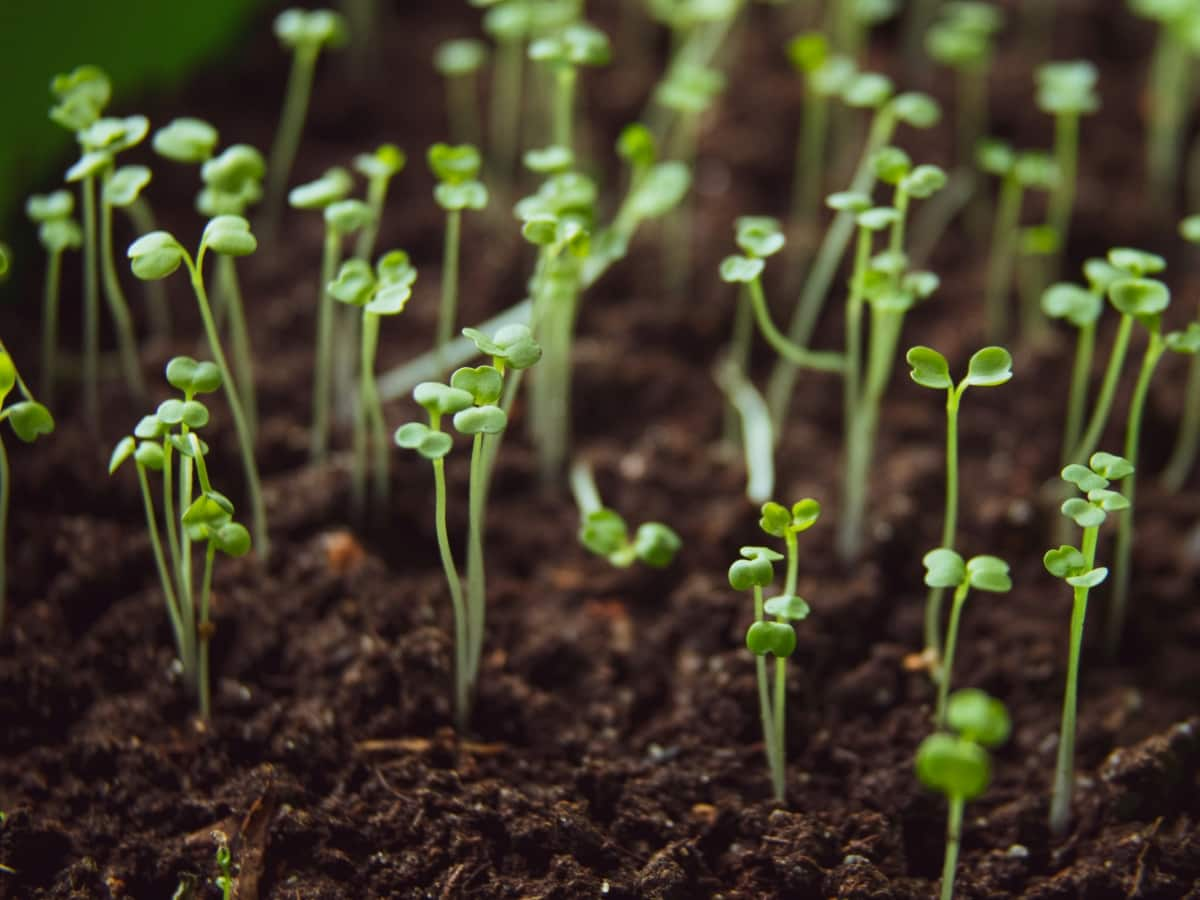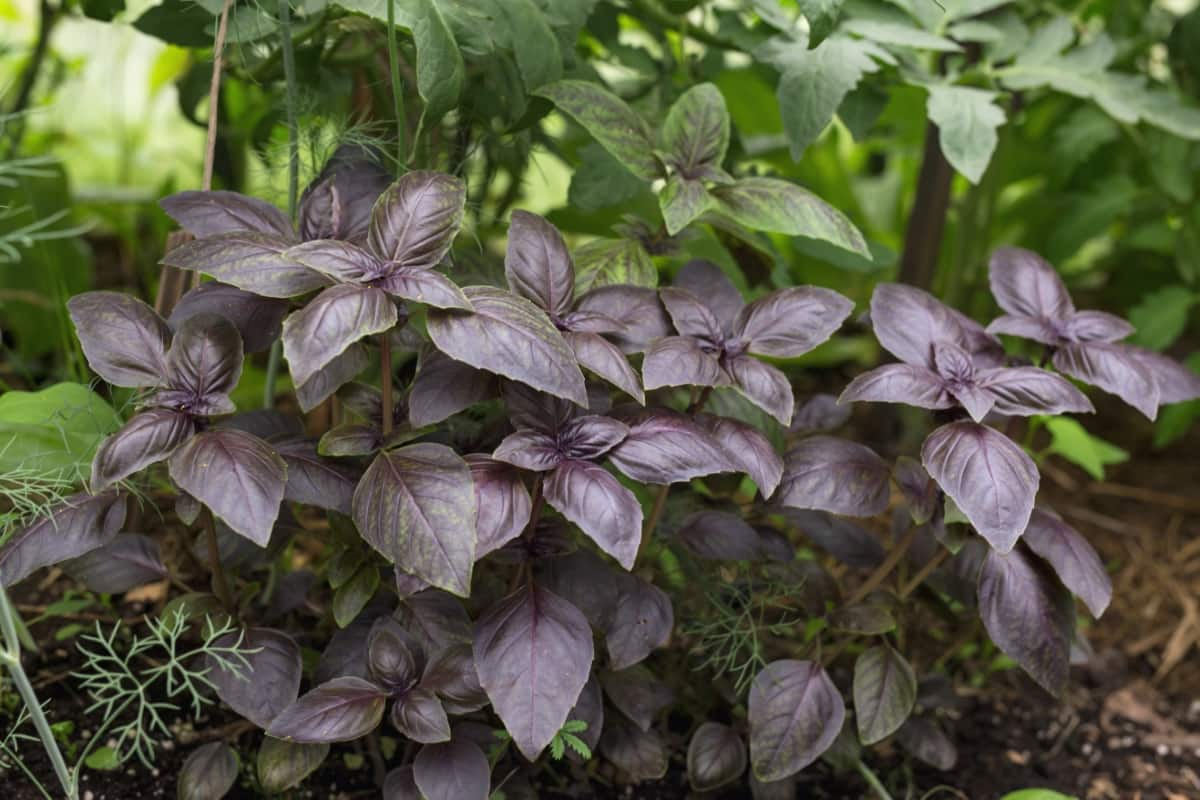Companion planting is a time-honored agricultural tradition practiced for thousands of years. Basil, a staple herb in many culinary gardens, is no stranger to this method, where plants are intentionally grown together for mutual benefit. Basil companion plants’ benefits extend to the garden’s overall health and yield, from deterring pests to enhancing soil fertility and increasing pollination.

There are many answers to the questions, “What grows well with basil?” and “What should you not plant next to basil?” Here we learn a list of good and bad companion plants for basil, the many benefits of such strategic planting, and how it all contributes to a thriving, organic garden.
Benefits of Companion Plants for Basils in the Garden
Companion planting is a crucial part of maintaining a healthy and fruitful garden. This method of co-planting involves pairing plants that help each other grow, resulting in increased yield and a more vibrant garden. One of the most noteworthy basil companion plants’ benefits is its ability to repel pests. The strong scent of basil is known to deter many common garden pests, reducing the need for harmful pesticides.
Moreover, companion planting with basil also helps improve the flavor of certain vegetables like tomatoes and peppers. Pairing basil with these vegetables can help enhance their taste, making them even more flavorful. In essence, the companion plants for basil serve a dual role – they contribute to the garden’s health and the quality of its produce.
Best Companion Plants for Basils to Deter Pests
Pest control is a significant concern for any gardener. Luckily, several plants work in tandem with basil to repel common pests. Companion plants for basil in this category include tomatoes and marigolds. Tomatoes can deter pests attracted to basil, while the strong scent of marigolds can deter pests like nematodes and insects. Additionally, when basil is planted next to cabbage or kohlrabi, it deters cabbage moths and other pests. This creates a healthier environment for basil and its companions to grow, ensuring a better yield.
Basil Companion Plants for Improved Pollination
Another significant basil companion plant benefit is improved pollination. When basil blooms, it attracts pollinators, which benefits the entire garden. Companion plants for basil that assist in this task include bee-friendly plants such as borage and calendula. These flowering plants draw in bees, which are crucial for pollination. These plants, alongside your basil, ensure a higher pollination rate, leading to a more bountiful harvest.
Companion Plants for Basil in Containers
If you’re short on space, don’t fret. Several companion plants for basil can thrive in containers alongside the herb. Consider planting basil with parsley, cilantro, or chives. These basil companion herbs create an attractive display, are convenient for kitchen use, and enjoy similar light and water conditions. However, remember that plants need adequate space to grow without nutrient competition.
In case you missed it: 6 Causes of Dying Basil Plants and How to Fix Them?

Companion Herbs for Basils in Organic Gardening
The benefits of basil companion plants aren’t confined to vegetables. Basil companion herbs, such as rosemary, thyme, and oregano, can be grown together organically for mutual benefits. The shared strong scents can deter pests, thrive in similar soil conditions, and be conveniently harvested together for a variety of culinary dishes.
Flowering Companion Plants for Basils to Attract Beneficial Insects
Attracting beneficial insects is another noteworthy benefit of companion planting. Basil’s aroma deters pests and invites beneficial insects to the garden. Flowering companion plants for basil, like marigolds and cosmos, also serve the same purpose. They attract insects like ladybugs, hoverflies, and lacewings that feed on aphids, thrips, and other harmful insects, thus helping maintain a natural balance in your garden.
Companion Vegetables for Basils in Raised Beds
Companion vegetables for basil in raised beds include those that benefit from the aromatic characteristics of basil. Tomatoes, peppers, and asparagus are among the vegetables that pair well with basil in a raised bed garden. The strong aroma of basil can enhance the flavor of these vegetables while also providing a deterrent against pests. Combining basil and these vegetables in a raised bed garden can help maximize your yield while minimizing pest damage.
Companion Plants for Basils to Improve Soil Fertility
A vital aspect of gardening is maintaining and improving soil fertility. Some plants, like beans and peas, improve soil fertility by fixing nitrogen – an essential nutrient for most plants. When these companion plants are paired with basil, they improve the soil’s nutrient content, which benefits the basil. Healthy soil is the backbone of a thriving garden, and the strategic use of companion plants can help you achieve this goal.
In case you missed it: How to Grow Basil from Cuttings: A Complete Planting Guide for Beginners

Companion Plants Chart for Basils in the Garden
A companion plants chart for basil can provide a quick reference for successful planting. Good companions for basil include tomatoes, peppers, oregano, and marigolds, among others. On the other hand, it’s best to avoid planting basil near rue or sage. This chart facilitates the development of a diverse and harmonious garden, maximizing the advantages of companion planting with basil.
Maintaining Balance with Basil in a Polyculture Garden
When discussing basil companion plants, we should also consider the broader picture of a polyculture garden, where various types of plants coexist. Basil can be a significant player in maintaining balance in such a setting. Planting basil alongside different vegetables, herbs, and flowers can lead to a harmonious blend, minimizing the need for external interventions such as synthetic fertilizers or pesticides.
The presence of basil, with its pest-repelling and flavor-enhancing properties, contributes to this healthy mix; therefore, as you plan your polyculture garden, strategically position basil with its companions like tomatoes, marigolds, and oregano to ensure a prosperous ecosystem.
Rotating Basil and Its Companion Plants
In addition to choosing the right companion plants for basil, it’s essential to consider plant rotation. This practice is used to prevent the depletion of vital soil nutrients and to curb the spread of diseases and pests. Basil, with its relatively short life cycle, is well-suited for rotation. After your basil plant’s life cycle concludes, opt for planting beans or peas to enhance soil nitrogen content.
In case you missed it: Frequently Asked Questions About Basil Farming

Then, in the following season, you can return to planting basil in the same spot, benefiting from the improved soil conditions. Hence, a well-planned rotation involving basil and its companion plants can lead to a sustainable and productive garden over time.
Conclusion
Understanding the best companion plants for basil, the bad companions, and the basil companion plants benefits can take your gardening game to a new level. Companion planting is a natural, effective method to boost your garden’s overall health and productivity. Whether you’re looking to deter pests, improve pollination, or enhance soil fertility, companion planting with basil offers an array of benefits to create a thriving, organic garden. So next time you ponder, “What grows well with basil?” or “What should you not plant next to basil?” this guide should help steer your gardening strategy in the right direction.
- Feed Your Flock for Less: Top 10 Tips to Save on Chicken Feed
- Ultimate Guide to Ossabaw Island Hog: Breeding, Raising, Diet, and Care
- Hatching Answers: The Top 10 Reasons Your Chickens Aren’t Laying Eggs
- Eggs and Economics: Breaking Down the Cost of Raising Backyard Chickens
- Defend Your Greens: Proven Methods to Keep Iguanas Out of Your Garden
- Ultimate Guide to Cinnamon Queen Chicken: A Comprehensive Guide for Beginners
- Ultimate Guide to California Tan Chicken: Breeding, Raising, Diet, Egg-Production and Care
- Ultimate Guide to Marsh Daisy Chicken: Breeding, Raising, Diet, and Care
- 10 Types of Chicken Farming Businesses You Can Start for Profits